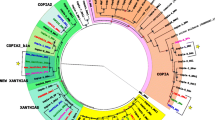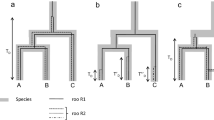Abstract
Transposition of a new Drosophila retrotransposon was investigated. Total genomic Southern analysis and polytene in situ hybridizations in D. buzzatii strains and other related species using a 6 kb D. buzzatii clone (cDb314) showed a dispersed, repetitive DNA pattern, suggesting that this clone contains a transposable element (TE). We have sequenced the cDb314 clone and demonstrated that it contains all the conserved protein sequences and motifs typical of retrovirus-related sequences. Although cDb314 does not include the complete TE, the protein sequence alignment demonstrates that it includes a defective copy of a new long terminal repeat (LTR) retrotransposon, related to the gypsy family, which we have named Osvaldo. Using a D. buzzatii inbred line in which all insertion sites are known, we have measured Osvaldo transposition rates in hybrids between this D. buzzatii line and its sibling species D. koepferae. The results show that Osvaldo transposes in bursts at high rate, both in the D. buzzatii inbred line and in species hybrids.
Similar content being viewed by others
References
Adams SE, Mellor J, Gull K, Sim RB, Tutte MF, Kingsman SM, Kingsman AJ (1987) The functions and relationships of TyVLP proteins in yeast reflect those of mammalian retroviral proteins. Cell 49:111–119
Arkhipova IR, Ilyin YV (1991) Properties of promoter regions of mdg1 Drosophila retrotransposon indicate that it belongs to a specific class of promoters. EMBO J 10:1169–1177
Arkhipova IR, Ilyin YV (1992) Control of transcription of Drosophila retrotransposons. BioEssays 14:161–168
Biémont CA, Aouar A, Arnault C (1987) Genome reshuffling of the copia element in an inbred line of Drosophila melanogaster. Nature 329:742–744
Blackman RK, Gelbart WM (1989) The transposable element hobo of Drosophila melanogaster. In: Berg DE, Howe MM (eds) Mobile DNA. American Society for Microbiology, Washington DC, pp 523–529
Brookfield JFY, Montgomery E, Langley CH (1984) Apparent absence of transposable elements related to the P elements of Drosophila melanogaster in other species of Drosophila. Nature 310:330–332
Charlesworth B, Langley CH (1989) The population genetics of Drosophila transposable elements. Annu Rev Genet 23:251–287
Clare J, Farabaugh P (1985) Nucleotide sequence of a yeast Ty element: evidence for an unusual mechanism of gene expression. Proc Natl Acad Sci USA 82:2829–2833
Covey SN (1986) Amino acid sequence homology in gag region of reverse transcribing elements and the coat protein gene of cauliflower mosaic virus. Nucleic Acids Res 14:623–633
Coyne JA (1989) Mutation rates in hybrids between sibling species of Drosophila. Heredity 63:155–162
Di Franco C, Pisano C, Dimitri P, Gigliotti S, Junakovic N (1989) Genomic distribution of copia like transposable elements in somatic tissues and during development of Drosophila melanogaster. Chromosoma 98:402–410
Doolittle RF, Feng DF, Johnson MS, McClure MA (1989) Origin and evolutionary relationships of retroviruses Q Rev Biol 64:1–30
Dowsett AP, Young MW (1982) Different levels of dispersed middle repetitive DNA along closely related species of Drosophila. Proc Natl Acad Sci USA 79:4570–4574
Eggleston WB, Johnson-Schlitz DM, Engels WR (1988) P-M hybrid dysgenesis does not mobilize other transposable element families in Drosophila melanogaster. Nature 331:368–70
Engels WR (1989) P elements in Drosophila melanogaster. In: Berg DE, Howe MM (eds) Mobile DNA. American Society for Microbiology, Washington DC, pp 437–484
Engels WR, Preston CR, Thompson P, Eggleston WB (1986) In situ hybridization of Drosophila salivary chromosomes with biotinylated DNA probes and alkaline phosphatase Focus 8:6–8
Evgen'ev NB, Yenikolopov GN, Peunova NJ, Ilyin YV (1982) Transposition of mobile genetic elements in interspecific hybrids of Drosophila. Chromosoma 85:375–386
Finnegan DJ (1989) The I factor and I-R hybrid dysgenesis in Drosophila melanogaster. In: Berg DE, Howe MM (eds) Mobile DNA. American Society for Microbiology, Washington DC, pp 503–518
Fontdevila A (1987) The unstable genome: an evolutionary approach. Genet Iber 39:315–349
Fontdevila A (1988) The evolutionary potential of the unstable genome. In: de Jong G (ed) Population genetics and evolution. Springer, Berlin, Heidelberg, pp 251–263
Fontdevila A, Pla C, Hasson E, Wasserman M, Sanchez A, Naveira H, Ruiz A (1988) Drosophila koepferae: a new member of the Drosophila serido (Diptera: Drosophilidae) superspecies taxon. Ann Entomol Soc Am 81:380–385
Friesen PD, Nissen MS (1990) Gene organization and transcription of TED, a lepidopteran retrotransposon integrated within the baculovirus genome. Mol Cell Biol 10:3067–3077
de Frutos R, Kimura K, Peterson KR (1989) In situ hybridization of Drosophila polytene chromosomes with digoxigenin-dUTP labeled probes. Trends Genet 5:366
Georgiev PG, Tchurikov NA, Ilyin YV, Georgieva SG, Mizrokhi LJ, Priimaagi AE, Gerasimova TI, Georgiev PG, Simonova OB, Kiselev SL, Kochieva EZ (1989) Mobile genetic elements in Drosophila melanogaster (recent experiments) Genome 31:920–928
Georgiev PG, Kiselev SL, Simonova OB, Gerasimova TI (1990) A novel transposition system in Drosophila melanogaster depending on the Stalker mobile genetic element. EMBO J 9:2037–2044
Gerasimova TI, Mizrokhi LJ, Georgiev GP (1984) Transposition bursts in genetically unstable Drosophila melanogaster. Nature 309:714–716
Gerasimova TI, Matjunina LV, Mizrokhi LJ, Georgiev GP (1985) Successive transposition explosions in Drosophila melanogaster and reverse transpositions of mobile dispersed genetic elements. EMBO J 4:3773–3779
Gerstel DU, Burns JA (1967) Phenotypic and chromosomal abnormalities asociated with the introduction of heterochromatin from Nicotiana otophora into N. tabacum. Genetics 56:483–502
Hagele K (1984) Different hybrid effects in reciprocal crosses between Chironomus thummi thummi and Ch. th. piger including spontaneous chromosome aberrations and sterility. Genetica 63:105–111
Harada K, Yukuhiro K, Mukai T (1990) Transposition rates of movable genetic elements in Drosophila melanogaster. Proc Natl Acad Sci USA 87:3248–3252
Haymer DS, Marsh JL (1986) Germ line and somatic instability of a white mutation in Drosophila mauritiana due to a transposable genetic element. Dev Genet 6:281–291
Hey J (1989) Speciation via hybrid dysgenesis: negative evidence from the Drosophila affinis subgroup. Genetica 78:97–104
Higgins DG, Bleasby AJ, Fuchs R (1992) CLUSTAL V: improved software for multiple sequence alignment Cabios 8:189–191
Hirsh VM, Olmsted RA, Murphey-Corb M, Purcell RH, Johnson PR (1989) An African primate lentivirus (SIVsm) closely related to HIV-2. Nature 339:389–392
Khan E, Mack JPG, Katz RA, Kulkosky J, Skalka AM (1990) Retroviral integrase domains: DNA binding and the recognition of LTR sequences. Nucleic Acids Res 19:851–860
Kim AI, Belyaeva ES, Aslaniam MM (1990) Autonomous transposition of gypsy mobile elements and genetic instability in Drosophila melanogaster. Mol Gen Genet 224:303–308
Labrador M, Naveira H, Fontdevila A (1990) Genetic mapping of the Adh locus in the repleta group of Drosophila by in situ hybridization. J Hered 81:83–86
Lankenau D-H, Huijser P, Jansen E, Miedema K, Hennig W (1988) Micropia: a retrotransposon of Drosophila combining structural features of DNA viruses, retroviruses and non-viral transposable elements. J Mol Biol 204:233–246
Leigh-Brown AJ, Ross SJ, Alphey LS, Flavell AJ, Gerasimova TI (1989) Instability in the ct MRZ strain of Drosophila melanogaster: role of P element functions and structure of revertants. Mol Gen Genet 218:208–213
Lozovskaya ER, Scheinker VSH, Evgen'ev MB (1990) A hybrid dysgenesis syndrome in Drosophila virilis. Genetics 126:619–623
Maniatis T, Fritsch EF, Sambrook J (1982) Molecular cloning: a laboratory manual. Cold Spring Harbor Laboratory, Cold Spring Harbor, New York
Martin G, Wiernasz D, Schedl P (1983) Evolution of Drosophila repetitive-dispersed DNA. J Mol Evol 19:203–213
McClintock B (1951) Chromosome organization and genic expression. Cold Spring Harbor Symp Quant Biol 16:13–47
McClure MA (1991) Evolution of retroposons by acquisition or deletion of retrovirus-like genes. Mol Biol Evol 8:835–856
McClure MA (1992) Sequence analysis of eukaryotic retroid proteins. Math computer modeling 16:121–136
Michaille J-J, Mathavan S, Gaillard J, Garel A (1990) The complete sequence of mag a new retrotransposon in Bombyx mori. Nucleic Acids Res 18:674
Miller DD (1950) Observations on two cases of interspecific hybridization with Drosophila athabasca. Am Nat 84:81–93
Naveira H, Fontdevila A (1985) The evolutionary history of Drosophila buzzatii. IX. High frequencies of new chromosome rearrangements induced by introgressive hybridization. Chromosoma 91:87–94
Naveira H, Fontdevila A (1986) The evolutionary history of Drosophila buzzatii. XII. The genetic basis of sterility in hybrids between D buzzatii and its sibling D serido from Argentina. Genetics 114:841–857
Naveira H, Fontdevila A (1991a) The evolutionary history of Drosophila buzzatii. XXII. Chromosomal and genic sterility in male hybrids of Drosophila buzzatii and Drosophila koepferae. Heredity 66:233–239
Naveira H, Fontdevila A (1991b) The evolutionary history of Drosophila buzzatii. XXI. Cumulative action of multiple sterility factors on spermatogenesis in hybrids of D buzzatii and D koepferae. Heredity 67:57–72
Naveira H, Pla C, Fontdevila A (1986) The evolutionary history of Drosophila buzzatii. XI. A new method for cytogenetic localization based on asynapsis of polytene chromosomes in interspecific hybrids of Drosophila. Genetica 71:199–212
Nével-Ninio M, Mariol M-C, Gans M (1989) Mobilization of the gypsy and copia retrotransposons in Drosophila melanogaster induces reversion of the OVOD dominant female-sterile mutations: molecular analysis of revertant alleles. EMBO J 8:1549–1558
Parkhurst SM, Corces VG (1987) Developmental expression of Drosophila melanogaster retrovirus like transposable elements. EMBO J 6:419–424
Pasyukova EG, Nuzhdin SV (1993) Doe and copia instability in an isogenic Drosophila melanogaster stock. Mol Gen Genet 240:302–306
Pasyukova EG, Belyaeva ES, Kogan GL, Kaidanov LZ, Gvozdev VA (1986) Concerted transpositions of mobile genetic elements coupled with fitness changes in Drosophila melanogaster. Mol Biol Evol 3:299–312
Piñol J, Francino O, Fontdevila A, Cabre O (1988) Rapid isolation of Drosophila high molecular weight DNA to obtain genomic libraries. Nucleic Acids Res 16:2736–2737
Rose MR, Doolittle WF (1983) Molecular biological mechanisms of speciation. Science 220:157–162
Sambrook J, Maniatis T, Fritsch EF (1989) Molecular cloning: a laboratory manual. Cold Spring Harbor Laboratory, Cold Spring Harbor, New York
Sanger F, Nicklen AR, Coulson AR (1977) DNA sequencing with chain terminating inhibitors. Proc Natl Acad Sci USA 74:5463–5467
Scheinker VSH, Lozovskaya ER, Bishop JG, Corces VG, Evgen'ev MB (1990) A long terminal repeat-containing retrotransposon is mobilized during hybrid dysgenesis in Drosophila virilis. Proc Natl Acad Sci USA 87:9615–9619
Schmidt ER (1984) Clustered and interspersed repetitive DNA sequence family of Chironomus. J Mol Biol 178:1–15
Shaw DD, Wilkinson P, Coates DJ (1983) Increased chromosomal mutation rates after hybridization between two subspecies of grasshoppers. Science 220:1165–1167
Shevelyov YY, Balakireva MD, Gvozdev VA (1989) Heterochromatic regions in different Drosophila melanogaster stocks contain similar arrangements of moderate repeats with inserted copia-like elements (MDG1). Chromosoma 98:117–122
Sokal RR, Rohlf FJ (1981) Biometry, 2nd edn. WH Freeman, San Francisco
Stacey SN, Lansman RA, Brock H, Grigliatti TA (1986) Distribution and conservation of mobile elements in the genus Drosophila. Mol Biol Evol 3:522–534
Sturtevant A H (1939) High mutation frequency induced by hybridization. Proc Natl Acad Sci USA 25:308–310
Thompson JN Jr, Woodruff RC (1978) Mutator genes-pacemakers of evolution. Nature 274:317–321
Vaury C, Bucheton A, Pelisson A (1989) The heterochromatic sequences flanking the I elements are themselves defective transposable elements. Chromosoma 98:215–224
Wasserman M (1982) Evolution of the repleta group. In: Ashburner M, Carson HL, Thompson JN (eds) The genetics and biology of Drosophila, vol 3b. Academic Press, London, pp 62–139
Wharton LT (1942) Analysis of the repleta group of Drosophila. Univ Texas Publ 4228:23–53
Wilke CM, Maimer E, Adams J (1992) The population biology and evolutionary significance of the Ty elements in Saccaromyces cerevisiae. Genetica 86:155–173
Xiong Y, Eickbush TH (1990) Origin and evolution of retroelements based upon their reverse transcriptase sequences. EMBO J 9:3353–3362
Youngren SD, Boeke JD, Sanders NJ, Garfinkel DJ (1988) Functional organization of the retrotransposon Ty from Saccharomyces cerevisiae: Ty protease is required for transposition. Mol Cell Biol 8:1421–1431
Yuki S, Inouye S, Ishimaru S, Kulkosky J, Skalka M (1986a) Nucleotide sequence characterization of a Drosophila retrotransposon, 412. Eur J Biochem 158:403–410
Yuki S, Ishimaru S, Inouye S, Saigo K (1986b) Identification of genes for reverse transcriptase-like enzymes in two Drosophila retrotransposons, 412 and gypsy; a rapid detection method of reverse transcriptase genes using YXDD box probes. Nucleic Acids Res 14:3017–3030
Author information
Authors and Affiliations
Additional information
This paper is dedicated posthumously to Osvaldo A. Reig in recognition of his contributions to evolutionary biology and his early appreciation of the role of transposable elements in evolution
Rights and permissions
About this article
Cite this article
Labrador, M., Fontdevila, A. High transposition rates of Osvaldo, a new Drosophila buzzatii retrotransposon. Molec. Gen. Genet. 245, 661–674 (1994). https://doi.org/10.1007/BF00297273
Received:
Accepted:
Issue Date:
DOI: https://doi.org/10.1007/BF00297273




